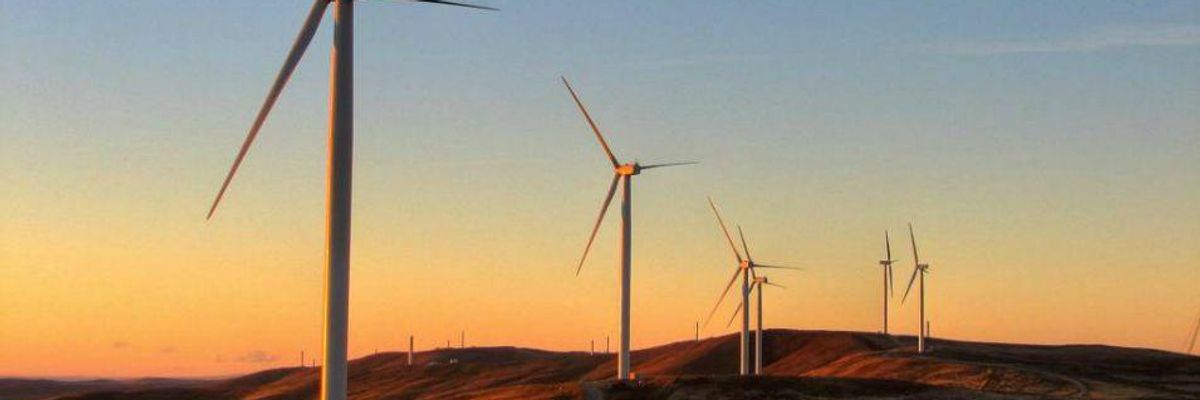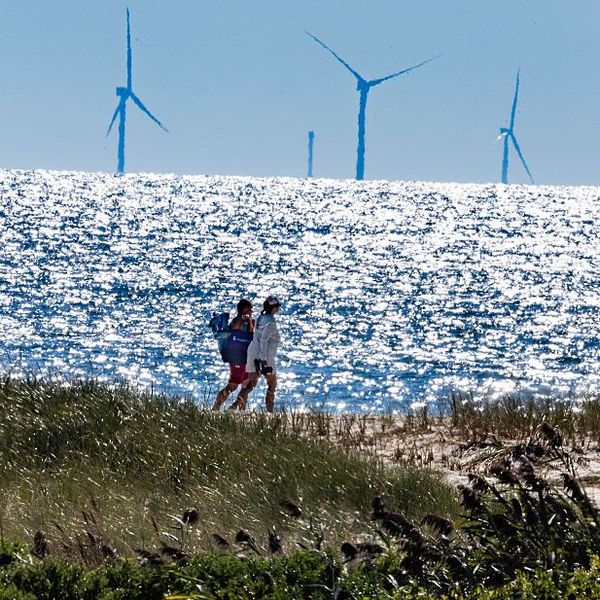
Wind turbines greet the sun.
How Corporations Own the Wind
The North Sea has long supported local economies—and with offshore wind becoming a popular choice of renewable energy.
The north-westerly gale billows and shakes the heavy white PVC of the marquee on the Portsoy harbourside, Aberdeenshire. At one end of the tent, a wall is taken up by a row of roller banners printed with text and logos, maps and images.
A man in his twenties with an alert haircut stands eager to do battle on behalf of the Moray West community consultation team.
Facing a half-interested audience sheltering from the wind, his task is to explain the great benefits that stand to accrue on the back of the Moray West wind farm that is moving towards construction far out in the Moray Firth, east of Inverness.
Shareholders
All the data, it seems, is on display in the exhibition. Off the coast of Caithness, in 150 feet of water, 65 turbines will be erected over 110 square miles of seabed—an area the size of Bristol.
This system that harvests the wind also generates profit for international corporations, and revenue for both the British monarchy and the Scottish aristocracy.
These will generate 860MW of electricity, enough for 30 per cent of Scotland's energy needs—according to the exhibition. They will also power up to 640,000 homes and save 1.1 million tonnes of CO2 every year.
The project will employ 60 personnel working out of its port base in Buckie, to the east of Portsoy. Everything about this bright future is clear, apparently.
But it is hard to find out who's actually behind this scheme. Who owns it? Closer inspection of a handout reveals that the initiative is being undertaken by Ocean Winds, but quite who they are, in reality, is unclear.
I later find out that Ocean Winds is owned by EDP Renewables, which is itself owned by EDP—the Portuguese oil and gas corporation, Energias de Portugal—which in turn is owned by China Three Gorges Corporation, BlackRock Inc, Oppidum Capital SL, Canada Pension Plan Investment Board, Amundi Asset Management, Norges Bank, Qatar Investment Authority, Sonatrach, and 'remaining shareholders'.
Transitioning
BlackRock is one of the world's largest investment companies. It holds, among other things, the biggest single shareholding in BP and is constantly criticised for its investment in fossil fuels. Here too is Sonatrach, the Algerian state oil and gas company.
And then the question of land ownership arises. Who owns the seabed that the turbines stand upon? Who owns the farmland that the cable crosses once it reaches the shore? Neither of these things is revealed in the community exhibition.
The seabed belongs to King Charles III, or rather the Crown Estate, which accrues rental income from the lease of the rights over the seabed to Ocean Winds for the duration of the project. The British monarch is reportedly the sixth largest landowner on Earth, so this revenue is but a fraction of his portfolio.
So this system that harvests the wind also generates profit for international corporations, and revenue for both the British monarchy and the Scottish aristocracy.
This may indeed be low-carbon energy, but where is the justice in this system to which we are transitioning with such startling haste?
This is an edited extract from an article published by Platform.
An Urgent Message From Our Co-Founder
Dear Common Dreams reader, The U.S. is on a fast track to authoritarianism like nothing I've ever seen. Meanwhile, corporate news outlets are utterly capitulating to Trump, twisting their coverage to avoid drawing his ire while lining up to stuff cash in his pockets. That's why I believe that Common Dreams is doing the best and most consequential reporting that we've ever done. Our small but mighty team is a progressive reporting powerhouse, covering the news every day that the corporate media never will. Our mission has always been simple: To inform. To inspire. And to ignite change for the common good. Now here's the key piece that I want all our readers to understand: None of this would be possible without your financial support. That's not just some fundraising cliche. It's the absolute and literal truth. We don't accept corporate advertising and never will. We don't have a paywall because we don't think people should be blocked from critical news based on their ability to pay. Everything we do is funded by the donations of readers like you. Will you donate now to help power the nonprofit, independent reporting of Common Dreams? Thank you for being a vital member of our community. Together, we can keep independent journalism alive when it’s needed most. - Craig Brown, Co-founder |
The north-westerly gale billows and shakes the heavy white PVC of the marquee on the Portsoy harbourside, Aberdeenshire. At one end of the tent, a wall is taken up by a row of roller banners printed with text and logos, maps and images.
A man in his twenties with an alert haircut stands eager to do battle on behalf of the Moray West community consultation team.
Facing a half-interested audience sheltering from the wind, his task is to explain the great benefits that stand to accrue on the back of the Moray West wind farm that is moving towards construction far out in the Moray Firth, east of Inverness.
Shareholders
All the data, it seems, is on display in the exhibition. Off the coast of Caithness, in 150 feet of water, 65 turbines will be erected over 110 square miles of seabed—an area the size of Bristol.
This system that harvests the wind also generates profit for international corporations, and revenue for both the British monarchy and the Scottish aristocracy.
These will generate 860MW of electricity, enough for 30 per cent of Scotland's energy needs—according to the exhibition. They will also power up to 640,000 homes and save 1.1 million tonnes of CO2 every year.
The project will employ 60 personnel working out of its port base in Buckie, to the east of Portsoy. Everything about this bright future is clear, apparently.
But it is hard to find out who's actually behind this scheme. Who owns it? Closer inspection of a handout reveals that the initiative is being undertaken by Ocean Winds, but quite who they are, in reality, is unclear.
I later find out that Ocean Winds is owned by EDP Renewables, which is itself owned by EDP—the Portuguese oil and gas corporation, Energias de Portugal—which in turn is owned by China Three Gorges Corporation, BlackRock Inc, Oppidum Capital SL, Canada Pension Plan Investment Board, Amundi Asset Management, Norges Bank, Qatar Investment Authority, Sonatrach, and 'remaining shareholders'.
Transitioning
BlackRock is one of the world's largest investment companies. It holds, among other things, the biggest single shareholding in BP and is constantly criticised for its investment in fossil fuels. Here too is Sonatrach, the Algerian state oil and gas company.
And then the question of land ownership arises. Who owns the seabed that the turbines stand upon? Who owns the farmland that the cable crosses once it reaches the shore? Neither of these things is revealed in the community exhibition.
The seabed belongs to King Charles III, or rather the Crown Estate, which accrues rental income from the lease of the rights over the seabed to Ocean Winds for the duration of the project. The British monarch is reportedly the sixth largest landowner on Earth, so this revenue is but a fraction of his portfolio.
So this system that harvests the wind also generates profit for international corporations, and revenue for both the British monarchy and the Scottish aristocracy.
This may indeed be low-carbon energy, but where is the justice in this system to which we are transitioning with such startling haste?
This is an edited extract from an article published by Platform.
The north-westerly gale billows and shakes the heavy white PVC of the marquee on the Portsoy harbourside, Aberdeenshire. At one end of the tent, a wall is taken up by a row of roller banners printed with text and logos, maps and images.
A man in his twenties with an alert haircut stands eager to do battle on behalf of the Moray West community consultation team.
Facing a half-interested audience sheltering from the wind, his task is to explain the great benefits that stand to accrue on the back of the Moray West wind farm that is moving towards construction far out in the Moray Firth, east of Inverness.
Shareholders
All the data, it seems, is on display in the exhibition. Off the coast of Caithness, in 150 feet of water, 65 turbines will be erected over 110 square miles of seabed—an area the size of Bristol.
This system that harvests the wind also generates profit for international corporations, and revenue for both the British monarchy and the Scottish aristocracy.
These will generate 860MW of electricity, enough for 30 per cent of Scotland's energy needs—according to the exhibition. They will also power up to 640,000 homes and save 1.1 million tonnes of CO2 every year.
The project will employ 60 personnel working out of its port base in Buckie, to the east of Portsoy. Everything about this bright future is clear, apparently.
But it is hard to find out who's actually behind this scheme. Who owns it? Closer inspection of a handout reveals that the initiative is being undertaken by Ocean Winds, but quite who they are, in reality, is unclear.
I later find out that Ocean Winds is owned by EDP Renewables, which is itself owned by EDP—the Portuguese oil and gas corporation, Energias de Portugal—which in turn is owned by China Three Gorges Corporation, BlackRock Inc, Oppidum Capital SL, Canada Pension Plan Investment Board, Amundi Asset Management, Norges Bank, Qatar Investment Authority, Sonatrach, and 'remaining shareholders'.
Transitioning
BlackRock is one of the world's largest investment companies. It holds, among other things, the biggest single shareholding in BP and is constantly criticised for its investment in fossil fuels. Here too is Sonatrach, the Algerian state oil and gas company.
And then the question of land ownership arises. Who owns the seabed that the turbines stand upon? Who owns the farmland that the cable crosses once it reaches the shore? Neither of these things is revealed in the community exhibition.
The seabed belongs to King Charles III, or rather the Crown Estate, which accrues rental income from the lease of the rights over the seabed to Ocean Winds for the duration of the project. The British monarch is reportedly the sixth largest landowner on Earth, so this revenue is but a fraction of his portfolio.
So this system that harvests the wind also generates profit for international corporations, and revenue for both the British monarchy and the Scottish aristocracy.
This may indeed be low-carbon energy, but where is the justice in this system to which we are transitioning with such startling haste?
This is an edited extract from an article published by Platform.
